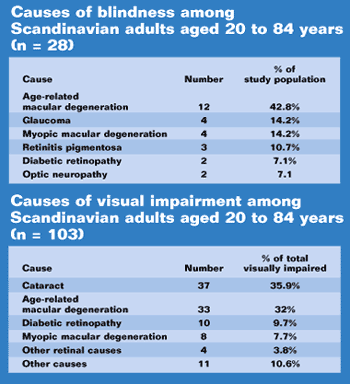Scandinavian health systems should prepare for rise in low vision
A Copenhagen-based study highlights the need for public education programs.
Age-related macular degeneration is the leading cause of blindness and the second leading cause of visual impairment among elderly Scandinavians, a Copenhagen-based population study found.
Because there are few medical interventions that prevent vision loss from the disease, the results of the study may foretell the development of a potentially significant public health problem. The proportion of the Scandinavian population aged 65 years and older is projected to increase 61% by the year 2040, according to Helena Buch, MD, first author of the study.
“Our data suggests that the [Danish] ophthalmic health care system should adjust for the demands of the fast growing elderly population. The increasing need for medical counseling, screening, preventive intervention, treatment and rehabilitative services — especially for patients with AMD and cataract — will put increasing pressure on the system,” she told Ocular Surgery News in an interview.
Although the study was limited to a population living in Copenhagen, the results can be applied to other Scandinavian populations, according to Dr. Buch and her study colleague Niels Vesti Nielsen, MD. The population of Denmark and the country’s health care system are comparable to those in other Scandinavian countries, Dr. Buch said.
She said educating additional ophthalmologists and expanding cataract services could help reduce the potential strain on health care systems. Public education could also be an important tool for increasing awareness of prevention, treatment and rehabilitation options, she said.
Population-based study
 Source: Buch H et al |
Dr. Buch conducted the study in cooperation with colleagues at the National University Hospital, Bispebjerg University Hospital and Hvidovre University, all in Copenhagen.
Participants were identified from the study population included in the third Copenhagen City Heart Study (CCHS III), a prospective population-based study conducted from 1991 to 1994.
To limit nonresponse in the current study, the researchers limited participants to adults between 20 and 84 years of age. Questionnaires were used to identify those with vision impairment or blindness. The data were then confirmed by ophthalmic records.
According to the study, out of 9,980 participants, the researchers identified 103 people with visual impairment (0.66% prevalence). These participants had a mean age of 73 years. Of the 103 visually impaired people included in the study, 88 (85.4%) were aged 65 to 84 years.
The three main causes of visual impairment, accounting for 77.6% of all cases, were cataract, AMD and diabetic retinopathy. The three main causes of blindness, which accounted for 71.4% of all cases, were AMD, glaucoma and myopic macular degeneration.
The authors noted that visual impairment from cataract increased by seven times and visual impairment and blindness from AMD rose 15 times by decade of age (i.e., from 70 to 74 years, to 80 to 84 years).
Visual impairment was nine times more common among persons aged 65 to 84 years compared to persons aged 20 to 64 years (P < .001). Cataract was the leading cause of visual impairment (39.7%) in the older age group, followed by AMD (36.3%).
Similarly, blindness was five times more prevalent in the older age group, with 75% of the blind subjects (21 of 28) aged 65 or older (P = .001). Among these 21 older individuals, AMD was the most significant cause (57.1%) of blindness.
Important implications
According to Dr. Buch, the most important finding in the study was that AMD and cataract are the primary causes of age-related vision loss among elderly persons, accounting for 65% of visual impairment and 42.8% of blindness among adult Danes.
The study highlights a need for further development of public education programs directed toward diabetic patients and elderly persons at risk for cataracts, glaucoma and AMD, she said.
“It is my experience that many people, especially elderly persons, are not aware of preventive, treatment and rehabilitative options or have anxiety regarding treatment due to lack of information. They thus suffer from loss of vision,” she said. “This may explain why 23% of the cases in our population had potential for improved vision with appropriate surgical intervention, and why cataract remains a significant cause of visual impairment among elderly subjects.”
According to Dr. Buch, this finding is supported by a recent Danish cataract surgery registration that showed that eight per 1,000 Danes were operated on for cataract in 2003, a number which doubled over the previous decade, she said.
She noted that the study should also help government representatives develop programs for visually impaired or blind persons, especially for the growing elderly population, which she said is often overlooked.
“One of the very elderly participants told me that the most terrible thing that could happen to a visually disabled person was to be placed in a nursing home, as the staff and surroundings could not meet the requirements of a visually disabled person. This may point to a need for more resources for aides, rehabilitation and daily care for the elderly visually disabled,” she said.
For Your Information:Reference:
- Helena Buch, MD, can be reached at Department of Ophthalmology, E 2061, National University Hospital (Rigshospitalet), Blegdamsvej 9, DK-2100, Copenhagen Ø, Denmark; fax: +45-35-45-22-90; e-mail: hbh@dadlnet.dk.
- Buch H, Vinding T, et al. Prevalence and causes of visual impairment and blindness among 9,980 Scandinavian adults. Ophthalmol. 2004;111:53-61.
